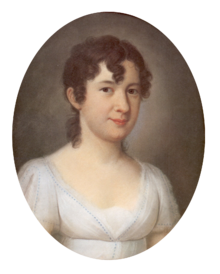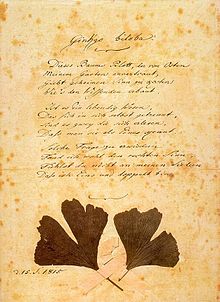Gingo biloba

Gingo biloba (also: Ginkgo biloba ) is a poem about the two-part (Latin: biloba) leaf of a ginkgo tree, which Johann Wolfgang von Goethe wrote in September 1815 at the age of 66 and dedicated to his late love Marianne von Willemer . In 1819 it was published in his West-Eastern Divan Collection .
Goethe consciously chose the spelling “Gingo” in the first version in order to avoid the hard consonant “k” in the title.
Emergence
The poem about the split (Latin: biloba) leaf of a ginkgo tree, which Johann Wolfgang von Goethe wrote at the age of 66, is dedicated to his late love, Marianne von Willemer . Due to its shape, the ginkgo leaf represents a symbol of friendship . The first version of the poem is dated September 15, 1815, when Goethe met Marianne von Willemer on the banks of the Main during a five-week stay in Frankfurt and there several times ; For a week Goethe even lived in the Roten Männchen , Willmer's city apartment, the rest of the time in the Gerbermühle .
It is said that Goethe looked at the leaves of the ginkgo and pondered their shape. As an expression of his affection, he sent one of the sheets to Marianne von Willemer, the third wife of his Frankfurt friend, the banker Johann Jakob von Willemer. She was more than twenty years younger than himself. The art collector and writer Sulpiz Boisserée , a friend of Goethe, mentions in a diary entry from September 15, 1815 - he traveled from the Gerbermühle to Heidelberg with Goethe on September 18 - about the genesis of the poem " Gin (k) go biloba ":
“Cheerful evening. G. had sent a leaf of Ginkho (sic) biloba to Wilemer from the city as a symbol of friendship. It is not known whether it is one that divides into two or two that combine into one. Such was the content of the verse. "
content
The first version of the poem reads:
Gingo Biloba
This leaf of the tree, which is
entrusted to My garden from the east ,
Gives a secret sense to taste,
How it edifies the knower ,
Is it a living being, Which
separates itself into itself?
Are there two who choose to
be known as one?
To answer such a question,
I found the right sense,
don't you feel in my songs
that I am one and two?
The heading and the first line indicate that this poem is a natural leaf of the ginkgo that is included in the book Suleika of the West-Eastern Divan. The original version as calligraphic handwriting on a single sheet of paper dated September 15, 1815 reinforces this idea. In the print version, however, this single sheet character is lost.
reception
For a long time, Goethe's poem was only known from a letter he sent from Heidelberg to Rosine Städel in Frankfurt am Main on September 27, 1815 . Hence the assumption that the ginkgo leaf came from Heidelberg. The sinologist Günther Debon located Goethe's ginkgo poem on the terrace of the Heidelberg Castle . The ginkgo in question, the leaf of which Goethe sent to Marianne von Willemer as a symbol of friendship, stood directly opposite the Goethe memorial plaque and was planted in 1795. As recently as 1928 it was said that the ginkgo tree in the Heidelberg castle garden is " still the same one that Goethe owed the inspiration for his beautiful poem ". The tree was probably still in place in 1936, but it no longer exists today. However, Goethe research has had the fair copy of the poem since 1965. The letter with the poem, with which Goethe enclosed two ginkgo leaves, can be seen today in the Goethe Museum in Düsseldorf . Date and diary entries of Boisserée and Goethe occupy Frankfurt as place of composition, although it remains uncertain whether the ginkgo leaf from the garden of the pharmacist Salzwedel , from the gardens of Karl Andreae-Bansa , Schaumainkai 27, or Peter Anton Brentano , Rödelheim , dates . (→ Ginkgo in Rödelheim ). In all three gardens that Goethe knew and visited, ginkgos are occupied at the age that can be inferred from the leaf.
Around 1815 the Weimar court gardener Johann Conrad Sckell planted a ginkgo at Goethe's behest in Weimar behind the Princely House in today's Puschkinstrasse, which is still there.
Musical reception
Apparently Goethe's poem has only recently been received musically. In 1966 Karl Marx published a setting of the poem in his cycle Drei Lieder after poems by JW von Goethe for tenor and piano op. 65 (new version 1981). Timo Jouko Herrmann set the text to music in 2002 as a duet for soprano, mezzo-soprano and piano. Wolfgang Rihm integrated the poem into his 2004 cycle one and two. 5 songs from the twilight for baritone and piano. Ricarda Rätz (* 1967) created another setting of the poem for voice and guitar for her Goethe song cycle One and Two .
Translator award
In 2018 the Freundeskreis Literaturhaus Heidelberg donated the Ginkgo-Biloba translator award for poetry .
literature
- Wolfgang-Hagen Hein, Dietrich Andernacht: The garden of the pharmacist Peter Saltzwedel and Goethe's Ginkgo biloba . In: Annaliese Ohm / Horst Reber: Festschrift for Peter Wilhelm Meister for his 65th birthday on May 16, 1974. Hamburg 1975, pp. 303–311
- Siegfried Unseld : Goethe and the Ginkgo. A tree and a poem . Insel-Verlag IB 1188, Frankfurt am Main 1998. 20th edition 2006, ISBN 978-3-458-19188-9
- Reiner Wild: "This tree's leaf". On Goethe's poem Gingo biloba. Edition Literaturhaus, Heidelberg 2016. ISBN 978-3-921249-94-9
- Bernd Witte (ed.): Poems by Johann Wolfgang Goethe (interpretations). Philipp Reclam jun., Stuttgart 1995. ISBN 3-15-017504-6
Web links
Individual evidence
- ↑ Hein / Andernacht: Garten , p. 308f.
- ↑ http://www.ginkgomuseum.de/content/ginkgomuseum/goethe-und-ginkgo/

